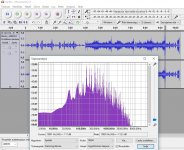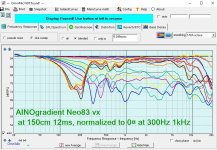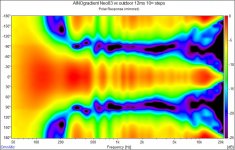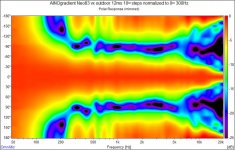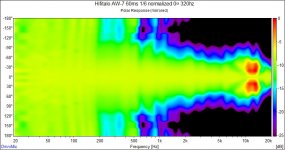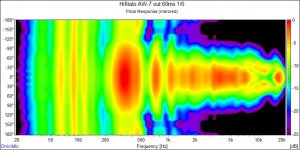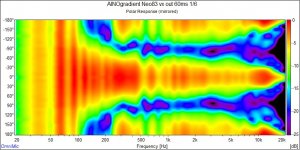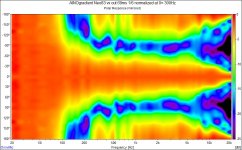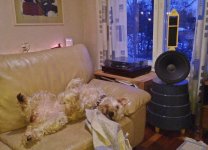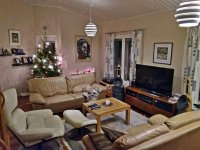Thanks, Jorma is an old school gentleman like Siegrfried, we had a nice chat.
Yes, Martions gave a very natural and fullbodied sound in a largish conference room. Astonishing performance and my guitarist-friend liked them very much too. It is easy to forget that you are listening to loudspeakers. Bullfrog active | Martion
Since this is diy-forum, I can confess that I started to think about a project with these Datasheet - 12CXA400Nd | Loudspeaker freaks
Yes, Martions gave a very natural and fullbodied sound in a largish conference room. Astonishing performance and my guitarist-friend liked them very much too. It is easy to forget that you are listening to loudspeakers. Bullfrog active | Martion
Since this is diy-forum, I can confess that I started to think about a project with these Datasheet - 12CXA400Nd | Loudspeaker freaks
The Bullfrog has a nice low crossover point compared to that Beyma though. It's basically a coaxial Fast. Very nice.
I made a revised version of AINOgradient project presentation. A link to it is now at my profile info.
During Christmas holidays I have been listening to different xo topologies carefully (again) as sanity check. My preferred xo has LR2 for monopole bass and LR4 for others.
All LR2 in duelund perfection for 2 octaves sounds too phasey specially with solo piano playing fast high notes. My guess is that this is because of interfereces of three drivers playing same note. Despite oh matched phase on-axis, spatially disributed sources make random intermodulations off-axis. And the dipole nature even multiplies that effect in a room. It is a nice "dolby enhaced sound" effect on many other kind of material, but when one learns to recognize it, it becomes annoying.
I wonder someone else has experiene about this?
All LR2 in duelund perfection for 2 octaves sounds too phasey specially with solo piano playing fast high notes. My guess is that this is because of interfereces of three drivers playing same note. Despite oh matched phase on-axis, spatially disributed sources make random intermodulations off-axis. And the dipole nature even multiplies that effect in a room. It is a nice "dolby enhaced sound" effect on many other kind of material, but when one learns to recognize it, it becomes annoying.
I wonder someone else has experiene about this?
^ Thank You!
When I spoke about the piano playing a note, we must remember the sound spectrum of piano, lots of harmonics!
When I spoke about the piano playing a note, we must remember the sound spectrum of piano, lots of harmonics!
Last edited:
A few years back was reading Lynn Olson's Nutshellhifi.com about audibility of out of band driver interaction. Looked for it, but in my brief skim couldn't locate the info (sigh). From memory (this will most likely be incorrect) he mentioned that you should shoot for at least 25dB down an octave above or below the crossover point while maintaining phase coherency. I ran many tests to find where I could not perceive interaction. To my surprise it was much greater, >-40dB!
Seeing that I ran into financial difficulties, my grand project is still sitting on hold. That will be changing here in a couple months, even secured a couple of investors after them hearing what I have currently. 😉
In the meantime used my MLTL paired up with a push-pull planar magnetic dipole for a mid and an amt for the top end. Dialed that in quite quickly, with my miniDSP using 4th order LR's crossing at 300 & 3000 while paying close attention to the out of band response. Level matched the drivers and time aligned them. Still requires a wee little tweaking, which will require a better mic than my current UMIK-1 but am more than happy with the results. Cello, Piano et al sound accurate without edginess or forwardness. Due to the quality of the planars the distortion levels are below audible floating around 0.25% or less from 100Hz and up at nominal listening levels. Polars are spot on.
Almost forgot, Happy New Year Juha
Seeing that I ran into financial difficulties, my grand project is still sitting on hold. That will be changing here in a couple months, even secured a couple of investors after them hearing what I have currently. 😉
In the meantime used my MLTL paired up with a push-pull planar magnetic dipole for a mid and an amt for the top end. Dialed that in quite quickly, with my miniDSP using 4th order LR's crossing at 300 & 3000 while paying close attention to the out of band response. Level matched the drivers and time aligned them. Still requires a wee little tweaking, which will require a better mic than my current UMIK-1 but am more than happy with the results. Cello, Piano et al sound accurate without edginess or forwardness. Due to the quality of the planars the distortion levels are below audible floating around 0.25% or less from 100Hz and up at nominal listening levels. Polars are spot on.
Almost forgot, Happy New Year Juha
Thx Greebster!
I was thinking about this today when walking the dog on icy paths on the hill. Beside backside radiation of dipoles, they also loose dipole and resemble more a gingerbread man above xo limit. This is another issue that makes dipole multiways even more problematic with shallow slopes.

I was thinking about this today when walking the dog on icy paths on the hill. Beside backside radiation of dipoles, they also loose dipole and resemble more a gingerbread man above xo limit. This is another issue that makes dipole multiways even more problematic with shallow slopes.

btw to tame the rear dipole radiation at the upper end of the range I used some microfiber towels folded up into about 30cm square (give or take a bit), which makes them about 50mm thick. They perform excellent for this task. Mine are skyblue
Here you can download some really good piano recordings of Beethoven's sonatas played by Canadian Robert Silverman. MP3 for free, MQA for beneficiary!
Robert Silverman's Beethoven Sonatas - Audio High

Robert Silverman's Beethoven Sonatas - Audio High

Thought the mp3 download would be small, well it is an mp3.
NOT... at 605MB's!
Just wondering just how big the MQA file size is if the mp3's are that size.
I mostly have FLAC files (>50%), around 200gigs of them currently. Staring at the box next to my desk it's packed full of CD's (100 or so) I have yet to get to. It's such a time consuming process that keeps getting put off til tomorrow... ya right lol
NOT... at 605MB's!
Just wondering just how big the MQA file size is if the mp3's are that size.
I mostly have FLAC files (>50%), around 200gigs of them currently. Staring at the box next to my desk it's packed full of CD's (100 or so) I have yet to get to. It's such a time consuming process that keeps getting put off til tomorrow... ya right lol
I got back to my last summer outdoor measurements and made new 0-180¤ polar plots of them. Measured outdoors at 150cm, 12ms gating, 10¤ steps. Some grass bounces betweet 500-700Hz. Notice cardioid response in transition area 100-200Hz between monopole bass and dipole mid-high sections.
Omnimic gives opportunity to normalization and polar graphics, still missing from the latest REW.
Omnimic gives opportunity to normalization and polar graphics, still missing from the latest REW.
Attachments
Last edited:
For comparison also 60ms windowed measurements and similar for a closed box coaxial with SEAS T18
Attachments
This very promising speaker has flat room response and wide dispersion - low DI up to upper treble. Atkinson liked the sound and so did the reviewer in SoundStage Hifi too
GoldenEar Technology Triton Reference loudspeaker | Stereophile.com
I have been listening to AINOgradients for 3½ years now. Minidsp 4x10HD and ICEPower modules have had power on all the time without problems. Looks like I'm almost finished with dsp settings too, and my wheaten terrier Willa likes them too!
Merry Christmas and a Happy new Year!
Her Master's Voice
GoldenEar Technology Triton Reference loudspeaker | Stereophile.com
I have been listening to AINOgradients for 3½ years now. Minidsp 4x10HD and ICEPower modules have had power on all the time without problems. Looks like I'm almost finished with dsp settings too, and my wheaten terrier Willa likes them too!
Merry Christmas and a Happy new Year!
Her Master's Voice
Attachments
Last edited:
The Finnish family owned Gradient have released a new edition in classic 1.n series, the Gradient 1.4
Like predecessors, it has a downfire (practically omnipole) bass, connected with cardioid mid and coaxial tweeter. I haven,t heard this yet, but some statements of sound are promising. It is a passive speaker and price is around 5000€/pair.
An externally hosted image should be here but it was not working when we last tested it.
Like predecessors, it has a downfire (practically omnipole) bass, connected with cardioid mid and coaxial tweeter. I haven,t heard this yet, but some statements of sound are promising. It is a passive speaker and price is around 5000€/pair.
The Finnish family owned Gradient have released a new edition in classic 1.n series, the Gradient 1.4
An externally hosted image should be here but it was not working when we last tested it.
Like predecessors, it has a downfire (practically omnipole) bass, connected with cardioid mid and coaxial tweeter. I haven,t heard this yet, but some statements of sound are promising. It is a passive speaker and price is around 5000€/pair.
I admire classic Gradient 1.0-1.3 and Helsinki designs - how uncompromisingly they pursue (and reach!) exactly the same design goals as mine in the flooder/FCUFS concept
This new 1.4 design looks interesting and familiar too. OTOH it is soooo ugly

- Home
- Loudspeakers
- Multi-Way
- Aino gradient - a collaborative speaker project

